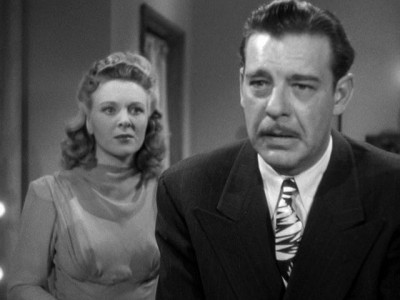
The interesting thing about this double dose of 1940s horror is that though both films have the word “ghost” in their titles, neither actually involves a ghost — frozen, invisible or otherwise. The Frozen Ghost (1945) is one of Lon Chaney’s “Inner Sanctum” series, and is about a radio mentalist/hypnotist who comes to believe that he murdered an obnoxious drunk heckler with the power of his mind. Invisible Ghost (1941) is the first — and in most ways, the best — of Bela Lugosi’s “Monogram Nine” from legendarily penurious producer Sam Katzman. (Determined trivia addicts should note that it’s also the final film appearance of Polly Ann Young, Loretta Young’s oldest sister.) In it, Lugosi plays Charles Kessler — as nice a guy as you could hope to meet, a pillar of the community and philanthropist. He has a couple of eccentricities, however. In the first place, once a year he has a dinner party with his wife — except, she ran off with his best friend years ago, so he’s actually by himself. In the second, said estranged wife (silent movie star Betty Compson) didn’t go too far — thanks to a car crash that left her a moron — and she prowls the area at night sometimes. The sight of her, unfortunately, drives kindly Mr. Kessler into a homicidal rage. (A personal embarrassment to say the very least.)

Of the two films, The Frozen Ghost is undeniably the more expensive production — though expensive is a very relative term here. The difference between a Universal B-picture (which this is) and a Monogram B-picture (which is about as high as Monogram got) is noteworthy. The “Inner Sanctum” series was primarily meant to keep Universal’s big horror star of the 1940s, Lon Chaney Jr., on movie screens for a minimum of budget. The films are only borderline horror — which didn’t keep them from being promoted as such or from being used to pad the “Shock Theater” TV packages in the late 1950s. They’re mostly mysteries — meaning Chaney didn’t have to have expensive makeup — but with a kind of occult spin.

This one is no exception. As is usually the case, you get Lon with a pencil mustache — and sporting a variety of snazzy neckties — getting mixed up with murderous doings and tepid mystery. (The films tend to have such small casts that it’s easy to guess the killer.) The worst thing about them — and one of the more endearing qualities — is that they not only require Chaney to act (not his strong suit), but to provide voice-overs of him thinking (definitely not a strong suit). The Frozen Ghost, however, throws in a creepy wax museum, a demented former plastic surgeon (Martin Kosleck), and a lot of Dutch angles for atmosphere. It all adds up to make the movie seem a lot better than it probably is if you stop to examine it very closely. But why on earth would you want to do that?

Invisible Ghost benefits from a better-than-average screenplay — assuming you can get past the casual absurdities — and direction by Joseph H. Lewis, who was desperate to prove he could direct something other than westerns. (He’d already gotten a reputation for shooting cowboy movies with artsy camera angles and compositions.) As a result, Lewis covers the film in clever camerawork, creative compositions and elaborate movement and focus changes. (I’ll bet the Monogram technicians just adored him, being more used to folks whose only concern was, “Is it in the frame?”) The pay-off was a super atmospheric movie with a script that had mostly good dialogue — and more than its share of looniness. However, the looniness factor is a prime selling point of the infamous “Monogram Nine.” These movies take place in a weird little world all their own — a world where every gardener is apt to have a secret underground room in which to stash (none too securely, mind you) the brain damaged survivor of a car wreck — and isn’t afraid to make use of it. (By the way, nothing even remotely like that shot of Lugosi sitting up under a sheet in a morgue occurs in the movie.)

From a Lugosi standpoint, the film is about 95 percent gem. His normal scenes — and especially those involving his interactions with black character actor (and Lugosi’s personal friend) Clarence Muse — are delightful. And they’re not at all the sort of material Lugosi generally got. He plays them with charm and innate dignity. (For that matter, Muse’s butler role is one of the most dignified roles you’ll find for a black actor in the 1940s.) There are few things more delightful in the realm of Lugosiana as Bela enthusing over the prospect of the new cook’s specialty with, “Apple pie! My, that will be a treat!” Having said that, there’s the other 5 percent of the film where Lugosi goes into his trance and runs about murdering folks. This latter stuff appears to have been directed by Lewis with no more instruction than, “Now, Bela, do your trance business!” It also seems that it never occurred to Lewis to suggest that Lugosi might want to tone it down a bit. And if he did, Lugosi must have ignored him. I’m not saying it isn’t entertaining, but I’m also not saying it ain’t ham — in thick slices. Some of it works pretty well, actually, but most of it is on the…well, amusing side. Overall, though, it’s one of the actor’s most interesting and subtle performances.
The Thursday Horror Picture Show will screen The Frozen Ghost and Invisible Ghost on Thursday, Jan. 17 at 8 p.m. in the Cinema Lounge of The Carolina Asheville and will be hosted by Xpress movie critics Ken Hanke and Justin Souther.



PLEASE NOTE: Tonight’s screening has been cancelled due to the weather. These titles will be rescheduled.